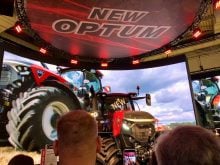DAFOE, Sask, – Protecting the environment in the face of a farm crisis is not an easy sell.
Just ask Henry Bzdel, reeve of the Rural Municipality of Elfros.
He said it’s a tough job explaining to local farmers how an environmental agency can reduce the number of cattle that can be kept in the district’s community pasture.
“I’ve got some small farmers in my district that have a couple of quarters and a family and they would really like to get a few cattle in here to help out with the bills,” he said.
Read Also

Agritechnica Day 2: The future of tractor power, building quicker crop apps and large farms and tech
Agritechnica Day 2: The future of tractor power, building quicker crop apps with Syngenta and large farms and tech
“They don’t have the space themselves and they have a legitimate question. Why not?”
The 2,500-acre pasture once held more than 600 head of cattle. It now contains 200 cow-calf pairs.
The Saskatchewan Wetland Conservation Corporation, which took ownership of the pasture from the province in 1996, considers that number to be a more sustainable level for the pasture to handle.
While the crown corporation leases the pasture to the RM, it provides the management strategy and limits the number of cattle that can be kept there, something that didn’t happen before SWCC got involved.
Largely made up of saline lowlands and seasonal marshes on the shore of Little Quill Lake, the pasture is supplemented by a few additional quarters of land provided by Ducks Unlimited.
Conditions improved
Tom Harrison of SWCC manages the project. He said the pasture is in much better condition now than when it was a “dumping ground” for all types of animals, including feeder steers.
“People drive by and it is has tall healthy looking green growth and they figure it should be able to support some more cattle,” Harrison said.
“As long as they can see some tall green plants, then it doesn’t have enough cattle. First it has to be the right kind of plants and then they have to remember that there is a whole season of grazing to support as well as some for next year.”
Dwayne Thompson, who raises cattle near Keliher, Sask., is leery about working with an environmental agency.
This summer he toured the Elfros and other Quill Lake area pastures that are under SWCC management. He is considering entering into a co-management agreement with the crown corporation with the aim of improving and maintaining a portion of the White Sand River that flows through some of his pasture.
Thompson said by working with SWCC, he would hope to provide well-managed riparian areas that would support both cattle and wildlife, while improving pasture and herd health.
“My concern in working with the environmental organizations is whose interest is being served here?” he said.
“Ultimately my interests must come first. My interest is to be able to raise a family and if I can do that and benefit wildlife and farm sustainably, then all the better. But first I have to be able to make a living.”
Thompson said farmers have mixed feeling about working with government and environmental groups. While they enjoy their independence, he said there are times when it makes sense to consider the bigger picture.
Bzdel agrees the community pasture is in better shape now than it was a few years ago. But he said the community is facing difficult times and many farmers feel the balance has shifted in favor of wildlife rather than producers.
Tough decision
Harrison understands this argument.
“It is hard for people to see the pasture that once had 600 head on it now see only (200 cow-calf pairs) and be hurting for income knowing that this year we could squeeze a bunch of cattle in for the season.”
But he said the fact remains that once a pasture is opened to larger numbers of animals, it is difficult to reduce that number again without hurting producers.
Bzdel agreed, but said there’s a limit to how much should be asked of farmers.
“You cannot move those numbers up and down like a yo-yo. A farmer needs to be able to rely on keeping his cattle on a pasture year after year. You have to have a place for the cattle year after year,” he said.
“But it still seems that we as farmers and municipal officials don’t have enough say in things like stocking rates. We abused the pasture in the past. We overgrazed it. We know that. But now it seems that birds are more important than farmers. It may not be the case but it seems like it for many farmers these days.”














